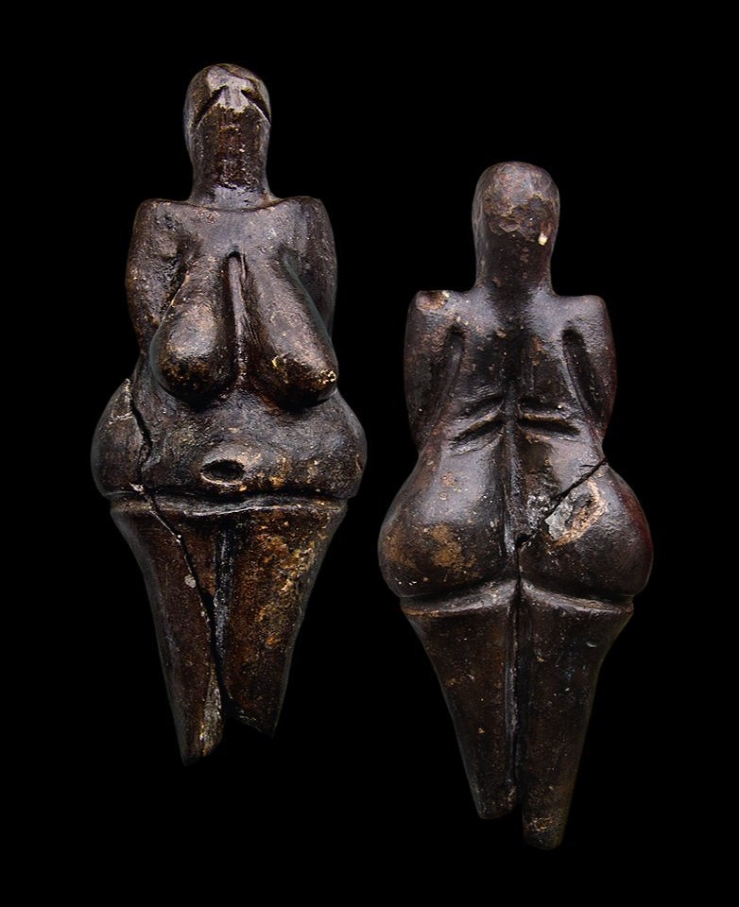Věstonický venuše... , Nyní je Věstonické venuše v držení...
Takhle asi ne 
27.2.2010 Venus of Věstonice the oldest ceramic work
Categories: Finds and rescue research in the Czech Republic , Calendar

Eleven years ago, the Venus of Věstonice received scientific recognition. Experts agreed that it is the oldest ceramic work in the world.
It had already been reported in several scientific publications. For example, in the respected Modern Ceramic Engineering by David W. Richerson in 2006. But the Venus of Věstonice is not the first surviving work by prehistoric artists, as it dates back to between 29,000 and 25,000 BC.
However, the Venus of Věstonice is exceptional mainly from a technological point of view. Originally, such statues were made from mammoth tusks. An example is the Swabian Venus, which was probably a pregnancy charm. However, the mammoth tusk gradually lost its importance as a material and ceramics were used. It gradually developed. Today, ceramics are also used for joint replacements.
Now the Venus of Věstonice is in the possession of the Moravian Museum in Brno. It is an 11.5 centimetre high black and grey figure made of fine spatter mixed with water. It represents an uncovered woman with large breasts, a distinct abdomen and full buttocks.
"'The face is not marked, only the eyes show two oblique lines. At the spine, the prehistoric artist left his fingerprint by burning it. The stylized figure shows that its author mastered the shape of the human body and wanted above all to emphasize the parts symbolizing fertility," says the Moravian Journal of Homeland History.
Last year, scientists came up with a surprising theory about the significance of prehistoric venus. They were dealt with by obesity experts. Statuettes of obese or pregnant women are most often seen as a symbol of fertility and motherhood. They date back to the time of gatherers and hunters in Europe during the Ice Age.
"But we wouldn't have expected obesity at that time. These statuettes are related to a period of extreme nutritional stress," said Richard Johnson, professor of Léwho is the lead author of a study on prehistoric statues of women.
He and his colleagues compared the waist-to-hip and waist-to-shoulder ratios in the famous Venusian women. They found that the figures closer to the glaciers were more obese. It was the advancing glacier areas from north to south as a result of falling temperatures that were a scourge to humans. So people were more stressed. "We found that obesity was highest as the glaciers got closer, and conversely, size decreased as the glaciers warmed and receded," Johnson explained.
Sources: the Moravian Journal of History, Obesity magazine, www.ct24.cz, www.novinky.cz
The article is included in categories:
- Archive of articles > Archaeology > Finds and rescue research in the Czech Republic
- Archive of articles > Calendar
Post
No teda Viky...hlídej si trochu tu češtinu... 
A když porovnám slovenskou a naší Venuši, vidím tam přeci jen pár rozdílů... 

Až bude někdo za 10 000 let zkoumat naší dobu a kulturu plnou porna kam se podíváš, taky určitě bude nějaký specialista tvrdit, že jsme v ohromné míře uctivali kult plodnosti. Obezita v době, kdy bojovali s nemilosrdnou přírodou kolem sebe včetně krutosti jiných kmenů se mi moc nezdá. Ale třeba se pletu...
Jj já spíš myslím, že chlapíkovi bylo smutno 😁😁... Určitě netušil jak nám zamotá hlavu 🙈..
Jinak ale dal si záležet. Je fantastická...
Lee - je, máš pravdu. Je to nádherná a správná žena.
Tak má pořádná slovanská žena vypadat, aby v zimě hřála a v létě vrhala stín. Napříč historií se nikdy nelíbila hubená, vychrtlá a s „malejma“ 
Ty šikmé rýhy nenaznačují oči, nýbrž účes, vlasy. Když autor dokázal tak přesně vymodelovat všechny zásadní a rozměrnější části je málo pravděpodobné, že by oči které jsou v poměru k sošce drobný detail a problematicky se naznačují, viz nepoměr velikosti ale současně přesného umístění pupečního otvoru, tedy je nepravděpodobné, že by oči odbyl jen šikmými nepřesnými a neproporcionálními zářezy.
fany1 - já ti nevím, podívej se třeba na Willendorfskou venuši - velké zvýrazněné proporce důležitých částí a k nim nepoměrné malé ručičky s prstíčky na megaňadrech  ... stvořitelé evidentně zvýrazňovali co je zajímalo nejvíce a zbytek tak nějak... takže to klidně mohou být oči..
... stvořitelé evidentně zvýrazňovali co je zajímalo nejvíce a zbytek tak nějak... takže to klidně mohou být oči..
namor - Jj , jenže v tomto by se člověk dokázal i utopit  .
.
No to je vtipné  Do systému se nedostanu, poslala jsem prosbu o opravu. Už jsem to jsem psala několikrát. Zvlášť tyto historické věci trvá najít, musím prohledávat Newton a zabere to opravdu hodně času. Dělám to po večerech a nocích po práci. Články látám z několika zdrojů a přepisuju je. Snažím se vybírat nejzajímavější věci. Pak to samozřejmě čtu ještě několikrát, ale někdy ten překlep už nevnímám. To je běžná věc. Tak prosím buďte shovívaví. Mně taky není příjemné, když pak po sobě najdu chybu. Překlepy jsou i na zpravodajských webech, kde to po autorovi čte ještě editor a korektor. Jsme lidi, ne roboti... Díky
Do systému se nedostanu, poslala jsem prosbu o opravu. Už jsem to jsem psala několikrát. Zvlášť tyto historické věci trvá najít, musím prohledávat Newton a zabere to opravdu hodně času. Dělám to po večerech a nocích po práci. Články látám z několika zdrojů a přepisuju je. Snažím se vybírat nejzajímavější věci. Pak to samozřejmě čtu ještě několikrát, ale někdy ten překlep už nevnímám. To je běžná věc. Tak prosím buďte shovívaví. Mně taky není příjemné, když pak po sobě najdu chybu. Překlepy jsou i na zpravodajských webech, kde to po autorovi čte ještě editor a korektor. Jsme lidi, ne roboti... Díky 

 Děkuju moc, vážím si toho
Děkuju moc, vážím si toho 
Neskutečný, co všechno keramika vydrží a jaký detaily zachová. Třeba ten otisk prstu vzadu nad levým horním žebrem  Díky za článek!
Díky za článek! 













